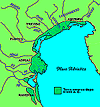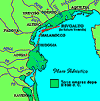 |
|
Capitolo 4 Lines of Venetian history
1 - It was born a State between land and sea
pag. 1 2 3 4 5 6

The "Venetia" in the first centuries of our era. | In the Roman Empire, the "X Regio", called "Venetia" and constituted by those which now are Veneto, Friuli, Trentino and Istria, bordered on the south on Adriatic sea . The border was not clean: it was instead a broad area subject to progressive orographic changes, with rivers of broad course that, combining their action with that of the see waves, gave origin to an environment of a marshy kind, with many lagoons. It was a " dynamic" ecosystem, a sort of " middle course" between the environment of inland, relatively stable, and the sea one. | | | This area, that is part of the land of the inhabitants of Veneto, assimilated to the Empire, was, in the Roman era, inhabited by fishermen, "salinari", (employed on the salt-works), hunters, all expert in the art of building and driving crafts suitable to the lagoon- and river- environment. The same area, among other things, perhaps for its "peace", was used as "vacation place", by the rich inhabitants of the near Roman cities (like Padua, Altino, Aquileia). | 
The first settlements after the invasions. | With the progressive breaking up of the Empire and with the invasions of the Germanic people, in particular in the sixth century, the lagoon-areas offered shelter to whom saw their lands and and their goods in power of the invaders: adventuring there through the rivers and channels was not easy, for those who did not know them, and the sandy beaches constituted a very good protection from a possible attack from the sea. In particular, the current lagoon of Venice was that one that greatly saw its people grow up. Of course this meant also a deep change of the social composition of the lagoon-inhabitants: many refugees were well-off people or landowners or farmers of the inland cities, like Altino and Oderzo. The first centres that created were Malamocco, on a shore, Torcello, an island at the exit of the river Sile and a group of islands at the center of the lagoon, the future Venice. | | | If the inland was in the hands of the Germanic people, the lagoons remained, on the contrary, in the Latin orbit, like part of the East Empire, depending directly by Ravenna. Till the beginning, then, it is established a deep link with the Byzantine world. At the end of the seventh century the inhabitants of the lagoons are no more governed by the " sea-tribunes", the Byzantine militar commanders, but they had an autonomous command under a "dux", from which the word " doge". It was born the first form of Venetian state (even if it is linked to Byzantium):the "Dogado". Towards 810 the government of the " doge" Agnello Particiaco moves from Malamocco and takes places in the area of Rivo Alto, at the centre of the lagoon. Conventionally it is opened the "History of Venice". |
|


